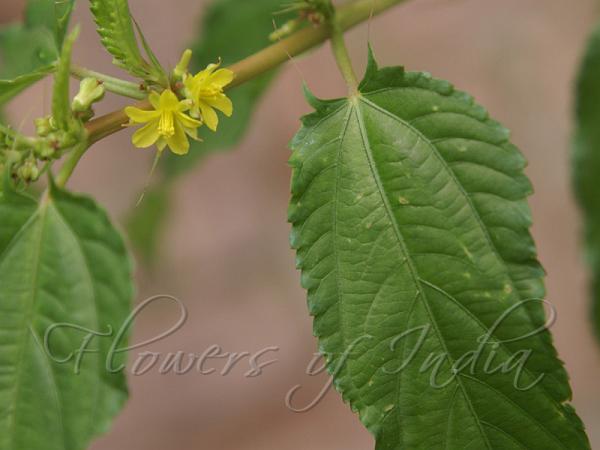|
| Wild Jute |
|

|

| File size | 120962 |
| Original date | 9/7/09 9:31 PM |
| Resolution | 800 x 600 |
| Flash | Flash did not fire, auto |
| Focal length | 50.0mm |
| Exposure time | 1/125s |
| Aperture | 5.6 |
| Focus Distance | |
| Metering Mode | Multi-segment |
| Camera make | SONY |
| Camera model | DSLR-A100 |
| Sensor type |
|
|
|
|
Photo: |
Botanical name: Corchorus trilocularis Family: Tiliaceae (Falsa family)
Synonyms: Corchorus aestuans, Corchorus fruticulosus, Corchorus triflorus
Synonyms: Corchorus aestuans, Corchorus fruticulosus, Corchorus triflorus
Wild Jute is a branched annual herb, up to 1 m tall, usually erect,
sometimes found prostrate due to browsing by cattle. Young branches are
purplish, sparsely hairy. Leaves are oblong to lanceshaped, up to 12 × 3.5
cm, hairless or hairy, particularly on the veins. Margins are toothed with
a long bristle on the 2 lowermost teeth. Flowers are borne in in 1-3
flowered leaf-opposed clusters. Flowers are yellow, with sepals narrowly
lanceshaped, as long as the petals. Petals are 4-5, 5-7 mm long, 2-2.5 mm
wide, obovate tapering to a short ciliate claw. Stamens are many. Fruit is
a slender more or less erect, cylindric, many-seeded capsule, straight or
slightly curved, up to 7 cm long, 3-4-angled with a rough surface. The
species name trilocularis comes from the three-chambered ovary.
Young tender leaves are cooked and eaten.
Medicinal uses: The leaves are used as a plaster to reduce swellings. The seeds are used in
the treatment of gripe and nausea.
The leaves are used as a plaster to reduce swellings. The seeds are used in
the treatment of gripe and nausea.
Medicinal uses:
 The leaves are used as a plaster to reduce swellings. The seeds are used in
the treatment of gripe and nausea.
The leaves are used as a plaster to reduce swellings. The seeds are used in
the treatment of gripe and nausea.| Identification credit: Gurcharan Singh | Photographed in Delhi. |
• Is this flower misidentified? If yes,